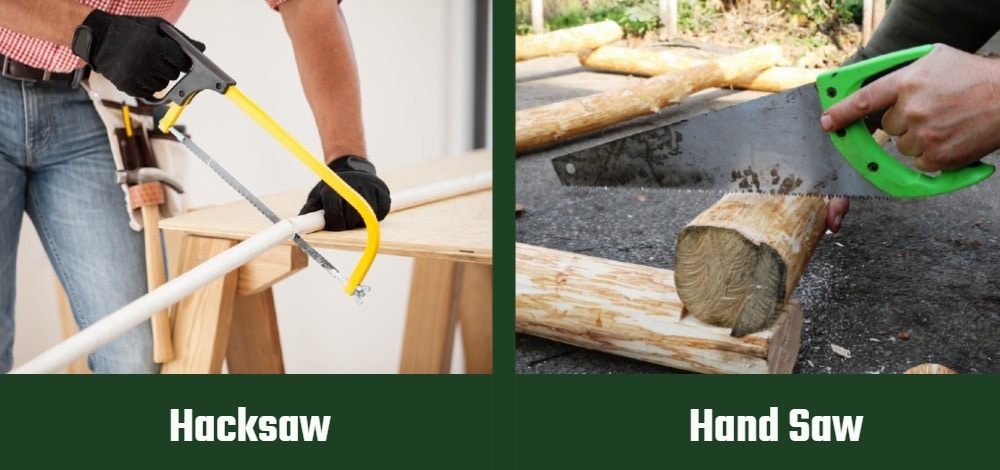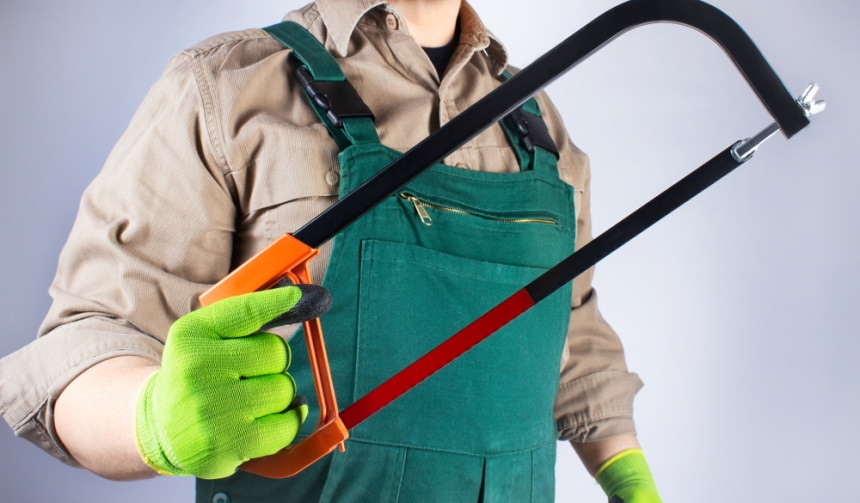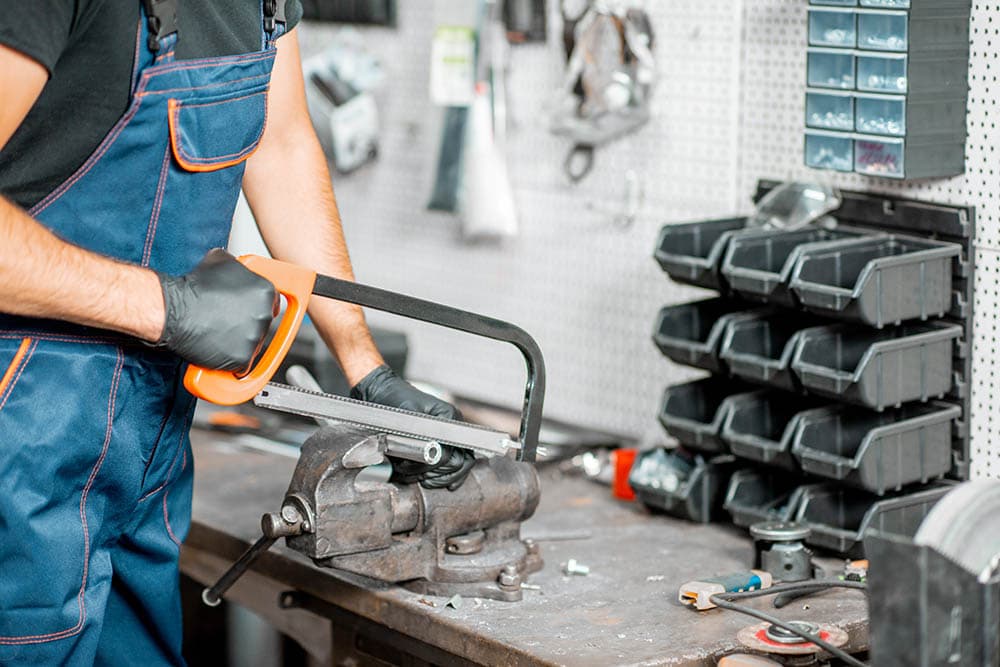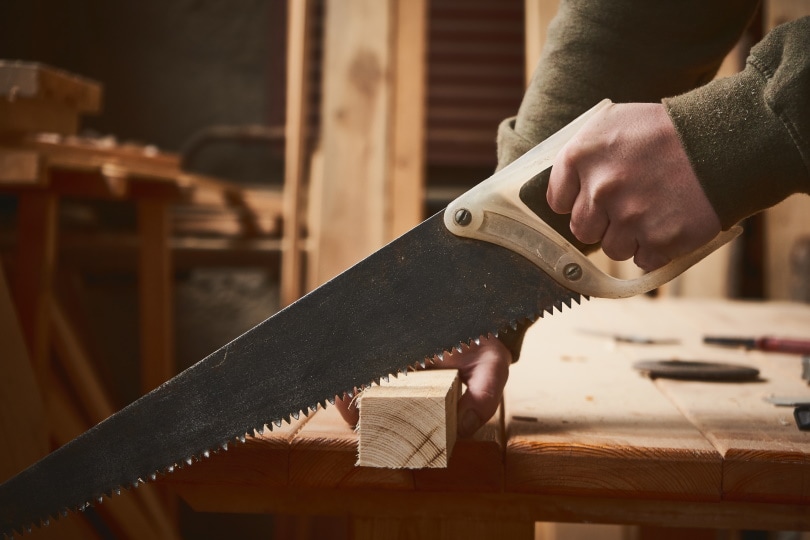Hacksaw vs. Hand Saw: Pros, Cons, Safety, & Types
-
Shea Cummings
- Last updated:

Whether you’re an avid DIYer or doing construction work for a living, there are many situations where you will be cutting material by hand. When it’s time to make manual cuts, it’s important to use the right saw for the job. If you’re using the wrong saw, the best-case scenario is that it takes way longer than it should. But the worst-case scenario is that you could actually damage the tool and the material.
Hacksaws and hand saws are two common types of manual-powered saws. Each has several variations depending on the task at hand. Read on as we discuss the pros and cons of each and when you should use either of them.

Overview of Hacksaws
At its core, a hacksaw is really another variation of your standard hand saw. But it’s designed to cut different materials. Another feature of hacksaws compared to most other saws is that they cut on the forward stroke instead of backstroke because of the tooth design.

Different Types of Hacksaw
Outside of several different lengths of the blade, a hacksaw also comes in a few variations. Let’s take a look at four types of hacksaw frames:
- Full-Size: These hacksaws are available in the most heavy-duty frames. You’ll probably want to go this route if you’re cutting harder materials.
- Junior: The junior ones are similar to the full-size, but they are a bit more compact to allow for use in tighter spaces. A junior hacksaw is typically a little less heavy-duty.
- Mini: The mini hacksaw is your best bet if you’re working in extremely tight spaces. They typically consist of a handle with a hacksaw blade attached. Because the frame only goes about halfway up the blade, you can reach into small areas where you couldn’t fit any other saw.
- Battery Power: If you’ve got the budget, a battery-powered hacksaw makes short work of small metal pipes. This would be an ideal tool for an electrician or a plumber who makes many daily cuts.

When to Use a Hacksaw
Steel, iron, aluminum, and plastic are all suitable uses for a hacksaw. The only thing to remember is that depending on what you’re cutting, you might need to change the blade (easy to do with a hacksaw). Different amounts of teeth per inch (TPI) cut specific materials better.
For example, if you’re cutting thin aluminum, you’ll want the highest TPI possible—30 plus would be ideal. Whereas if you’re cutting PVC pipe, you’ll want 5–10 TPI instead.
- Quickly change blades when one wears out
- Cuts metal, plastic, and other hard materials
- Super compact options available for different jobs
- Won’t cut wood very well
- Not easy to sharpen the blades
Overview of Hand Saws
Hand saws have been around for hundreds of years. Although, the ones we have today are often quite different than what early settlers would have used. If you buy a good hand saw, it will last for many, many cuts before you need to replace it.

Different Types of Hand Saw
There are many different types of hand saws available, depending on what you’re trying to do. We’ll cover four of the most common hand saws you’ll encounter here.
- General Purpose: Exactly as it sounds, this is a hand saw that will cut most wood and plastic materials. The blades will usually have between five and ten TPI.
- Jab Saw (keyhole saw): A jab saw is typically a wood or plastic handle with a 6–8-inch pointed blade. Its primary use is for cutting drywall. Because of its point, it can be “jabbed” into drywall that is already on the wall to cut out for electrical boxes, for example.
- Coping Saw: A coping saw typically has a higher TPI and has a thinner-than-normal blade. Its primary use is for making fine cuts where a nice finish is desired.
- Pruning Saw: There are many different sizes of pruning saws. They have a similar blade to a jab saw, but the main difference is that they are usually folding saws. These are ideal for pruning small tree branches. They make great additions for landscaping, backpacking, or camping.

When to Use a Hand Saw
Anytime you’re cutting wood is a good time for a hand saw if you’re going the manual route. Whether you’re crosscutting a sheet of plywood, working on a small project, or cutting dimensional lumber, a hand saw will work.
One similarity that a hand saw has with a hacksaw is its ability to cut plastic, like PVC pipes. Almost any hand saw will work for plastic because it’s pretty rare for them to have more than a 12–14 TPI blade.
- Cuts wood quickly and easily
- Cuts many types of plastic as well
- Many different variations are available
- Usually, you can’t change blades
- Not easy to sharpen
Primary Differences Between These Saws
Both saws are technically a form of a hand saw. However, they do have some significant differences. The most major one is the different materials they are designed to cut. In addition, a hacksaw’s blade is thin and flexible—almost like a metal band.
A less commonly known difference between them is the way they cut. Because of how the teeth are designed on a hacksaw blade, it cuts on the forward stroke (if the blade is on correctly). Whereas the average hand saw cuts as you pull it towards yourself.
Safety Practices for Saw Use
Using any manual hand saw is typically a relatively safe process compared to power saw use. However, you’ll still want to ensure you’re using the appropriate personal protective equipment (PPE) and safe work practices.
- Wear safety glasses
- Wear leather or cut-resistant work gloves
- Keep your free hand out of the cut zone
- Take your time with the cut
- Start your cut slowly and build up speed
- Use a lubricant when cutting metal
- Use the correct saw for the job

When to Use Either Saw
- Aluminum and steel conduit
- Thin aluminum sheets
- PVC pipe
- Resizing bolts
- Crosscutting lumber
- Tree branches
- Dimensional lumber (2×4, 4×4, etc.)
Conclusion
It’s unlikely you’ll get these saws confused as they look quite different and have clearly defined materials they should be used for. Neither of these saws is overly expensive, so it’s worth having each in your tool kit. Then you always have the right tool for the job on hand, and your weekend project is never on hold.
- See also: 7 types of hacksaw frames and blades
Featured Image Credit: Left: Hacksaw: antoniodiaz, Shutterstock | Right: Hand saw: Skyliz, Shutterstock
Contents

